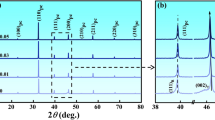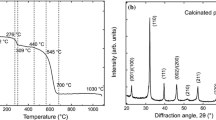Abstract
The maximum electromechanical property of piezoelectric ceramic is normally achieved at morphotropic phase boundary. Herein, we found that a maximum electrostrain is obtained in single rhombohedral phase region at the tricritical point (which is a single rhombohedral phase at room temperature) for BaTi1−xHfxO3 ceramics. The mechanism for electrostrain enhancement at tricritical point (TTP) was uncovered by analyzing its crystallographic feature. The results show that TTP (x = 0.11) exhibits largest electrostrain (S = 0.063%) at room temperature. And the TTP reveals a maximum crystallite size (66.3 nm) and minimum lattice strain (0.7 × 10−4). Further Raman results demonstrate a lowest Raman intensity occurs at TTP, which confirmed the specific crystallographic behavior. Therefore, a minimum lattice strain-induced low elastic energy could lower landau free energy, which is responsible for electrostrain enhancement at TTP. This work may provide a new insight for understanding and designing large electromechanical ceramics.







Similar content being viewed by others
References
K. Shibata, R. Wang, T. Tou, and J. Koruza, Applications of Lead-Free Piezoelectric Materials, MRS Bull., 2018, 43(8), p 612–616
L. Zhao, X. Ke, W. Wang, M. Fang, A. Xiao, L. He, L. Zhang, J. Gao, Y. Wang, and X. Ren, Mechanism of Electrostrain Enhancement in the Single Rhombohedral Phase Region of Ba(Ti1−xZrx)O3 Ceramics, J. Alloys Compd., 2019, 788, p 748–755
W. Liu and X. Ren, Large Piezoelectric Effect in Pb-Free Ceramics, Phys. Rev. Lett., 2009, 103(25), p 257602
H. Liu, J. Chen, H. Huang, L. Fan, Y. Ren, Z. Pan, J. Deng, L.-Q. Chen, and X. Xing, Role of Reversible Phase Transformation for Strong Piezoelectric Performance at the Morphotropic Phase Boundary, Phys. Rev. Lett., 2018, 120(5), p 05550
L. Wu, A. Podpirka, J.E. Spanier, and P.K. Davies, Ferroelectric, Optical, and Photovoltaic Properties of Morphotropic Phase Boundary Compositions in the PbTiO3-BiFeO3-Bi(Ni1/2Ti1/2)O3 System, Chem. Mater., 2019, 31(11), p 4184–4194
X. Hu, J. Gao, Y. Wang, Y. Liu, L. Li, D. Wang, F. Li, R. Yao, L. Zhong, and X. Ren, Reversible Domain-Wall-Motion-Induced Low-Hysteretic Piezoelectric Response in Ferroelectrics, J. Phys. Chem. C, 2019, 123(25), p 15434–15440
A. Mischenko, Q. Zhang, J. Scott, R. Whatmore, and N. Mathur, Giant Electrocaloric Effect in Thin-Film PbZr0.95Ti0.05O3, Science, 2006, 311(5765), p 1270–1271
J. Gao, X. Hu, L. Zhang, F. Li, L. Zhang, Y. Wang, Y. Hao, L. Zhong, and X. Ren, Major Contributor to the Large Piezoelectric Response in (1−x)Ba (Zr0.2Ti0.8)O3 − x(Ba0.7Ca0.3)TiO3 Ceramics: Domain Wall Motion, Appl. Phys. Lett., 2014, 104(25), p 252909
J. Gao, X. Hu, Y. Wang, Y. Liu, L. Zhang, X. Ke, L. Zhong, H. Zhao, and X. Ren, Understanding the Mechanism of Large Dielectric Response in Pb-Free (1 − x)Ba (Zr0.2Ti0.8)O3 − x(Ba0.7Ca0.3)TiO3 Ferroelectric Ceramics, Acta Mater., 2017, 125, p 177–186
J. Gao, Y. Wang, Y. Liu, X. Hu, X. Ke, L. Zhong, Y. He, and X. Ren, Enhancing Dielectric Permittivity for Energy-Storage Devices Through Tricritical Phenomenon, Sci. Rep., 2017, 7, p 40916
F. Li, D. Lin, Z. Chen, Z. Cheng, J. Wang, C. Li, Z. Xu, Q. Huang, X. Liao, and L.-Q. Chen, Ultrahigh Piezoelectricity in Ferroelectric Ceramics by Design, Nat. Mater., 2018, 17(4), p 349–354
L. Zhao, X. Ke, W. Wang, L. Zhang, C. Zhou, Z. Zhou, L. Zhang, and X. Ren, Electrostrain Enhancement at An Invisible Boundary in a Single Ferroelectric Phase, Phys. Rev. B, 2017, 95(2), p 020101
L.-F. Zhu, B.-P. Zhang, X.-K. Zhao, L. Zhao, F.-Z. Yao, X. Han, P.-F. Zhou, and J.-F. Li, Phase Transition and High Piezoelectricity in (Ba, Ca)(Ti1−xSnx)O3 Lead-Free Ceramics, Appl. Phys. Lett., 2013, 103(7), p 072905
Z. Zhao, V. Buscaglia, M. Viviani, M.T. Buscaglia, L. Mitoseriu, A. Testino, M. Nygren, M. Johnsson, and P. Nanni, Grain-Size Effects on the Ferroelectric Behavior of Dense Nanocrystalline BaTiO3 Ceramics, Phys. Rev. B, 2004, 70(2), p 024107
J. Li, D. Zhang, S. Qin, T. Li, M. Wu, D. Wang, Y. Bai, and X. Lou, Large Room-Temperature Electrocaloric Effect in Lead-Free BaHfxTi1−xO3 Ceramics Under Low Electric Field, Acta Mater., 2016, 115, p 58–67
D. Balzar, P. Ramakrishnan, and A. Hermann, Defect-Related Lattice Strain and the Transition Temperature in Ferroelectric Thin Films, Phys. Rev. B, 2004, 70(9), p 092103
W. Liu, D. Zhao, and S. Li, Large Electrostrain with Good Temperature Stability in Sodium Niobate Based Ceramics, RSC Adv., 2017, 7(5), p 2550–2554
M. Acosta, N. Khakpash, T. Someya, N. Novak, W. Jo, H. Nagata, G.A. Rossetti, and J. Rödel, Origin of the Large Piezoelectric Activity in (1 − x)Ba(Zr0.2Ti0.8)O3-x(Ba0.7Ca0.3)TiO3 Ceramics, Phys. Rev. B, 2015, 91(10), p 104108
F. Ernst, A. Rečnik, P. Langjahr, P. Nellist, and M. Rühle, Atomistic Structure of Misfit Dislocations in SrZrO3/SrTiO3 Interfaces, Acta Mater., 1998, 47(1), p 183–198
Y. Feng, W.-L. Li, D. Xu, Y.-L. Qiao, Y. Yu, Y. Zhao, and W.-D. Fei, Defect Engineering of Lead-Free Piezoelectrics with High Piezoelectric Properties and Temperature-Stability, ACS Appl. Mater. Interfaces, 2016, 8(14), p 9231–9241
I. Misirlioglu, S. Alpay, M. Aindow, and V. Nagarajan, Thermodynamic and Electrostatic Analysis of Threading Dislocations in Epitaxial Ferroelectric Films, Appl. Phys. Lett., 2006, 88(10), p 102906
I. Vrejoiu, G. Le Rhun, N. Zakharov, D. Hesse, L. Pintilie, and M. Alexe, Threading Dislocations in Epitaxial Ferroelectric PbZr0.2Ti0.8O3 Films and Their Effect on Polarization Backswitching, Philos. Mag., 2006, 86(28), p 4477–4486
S.S. Rajput and S. Keshri, Structural and Microwave Properties of (Mg, Zn/Co)TiO3 Dielectric Ceramics, J. Mater. Eng. Perform., 2014, 23(6), p 2103–2109
F.A. Rabuffetti and R.L. Brutchey, Local Structure of Ba1−xSrxTiO3 and BaTi1−yZryO3 Nanocrystals Probed by x-ray Absorption and x-ray Total Scattering, ACS Nano, 2013, 7(12), p 11435–11444
J. Chen, C. Fu, W. Cai, G. Chen, and S. Ran, Microstructures, Dielectric and Ferroelectric Properties of BaHfxTi1−xO3 ceramics, J. Alloys Compd., 2012, 544, p 82–86
B. Garbarz-Glos, W. Bąk, A. Molak, and A. Kalvane, Microstructure, Calorimetric and Dielectric Investigation of Hafnium Doped Barium Titanate Ceramics, Phase Trans., 2013, 86(9), p 917–925
Y. Yao, C. Zhou, D. Lv, D. Wang, H. Wu, Y. Yang, and X. Ren, Large Piezoelectricity and Dielectric Permittivity in BaTiO3-xBaSnO3 System: The Role of Phase Coexisting, EPL (Europhys. Lett.), 2012, 98(2), p 27008
A.K. Kalyani, K. Brajesh, A. Senyshyn, and R. Ranjan, Orthorhombic-Tetragonal Phase Coexistence and Enhanced Piezo-Response at Room Temperature in Zr, Sn, and Hf Modified BaTiO3, Appl. Phys. Lett., 2014, 104(25), p 252906
J. Gao, Y. Dai, X. Hu, X. Ke, L. Zhong, S. Li, L. Zhang, Y. Wang, D. Wang, and Y. Wang, Phase Transition Behaviours Near the Triple Point for Pb-Free (1 − x)Ba (Zr0.2Ti0.8)O3 − x(Ba0.7Ca0.3)TiO3 Piezoceramics, EPL (Europhys. Lett.), 2016, 115(3), p 37001
Y. Yonggang, Z. Chao, L. Duchao, W. Dong, W. Haijun, Y. Yaodong, and R. Xiaobing, Large Piezoelectricity and Dielectric Permittivity in BaTiO3-xBaSnO3 System: The Role of Phase Coexisting, EPL (Europhys. Lett.), 2012, 98(2), p 27008
M. Acosta, N. Novak, W. Jo, and J. Rödel, Relationship Between Electromechanical Properties and Phase Diagram in the Ba(Zr0.2Ti0.8)O3–x(Ba0.7Ca0.3)TiO3 Lead-Free Piezoceramic, Acta Mater., 2014, 80, p 48–55
D. Balzar, P.A. Ramakrishnan, and A.M. Hermann, Defect-Related Lattice Strain and the Transition Temperature in Ferroelectric Thin Films, Phys. Rev. B, 2014, 70(9), p 092103
A.L. Patterson, The Scherrer Formula for x-ray Particle Size Determination, Phys. Rev., 1939, 56(10), p 978–982
G. Williamson and W. Hall, X-ray Line Broadening from Filed Aluminium and Wolfram, Acta Metall., 1953, 1(1), p 22–31
A. Khorsand Zak, W.H. Abd Majid, M.E. Abrishami, and R. Yousefi, X-ray Analysis of ZnO Nanoparticles by Williamson-Hall and Size–Strain Plot Methods, Solid State Sci., 2011, 13(1), p 251–256
F. Desheng, I. Mitsuru, and K. Shin-ya, Invariant Lattice Strain and Polarization in BaTiO3-CaTiO3 Ferroelectric Alloys, J. Phys. Condens. Matter, 2010, 22(5), p 052204
H. Fu and R.E. Cohen, Polarization Rotation Mechanism for Ultrahigh Electromechanical Response in Single-Crystal Piezoelectrics, Nature, 2000, 403(6767), p 281
B. Vincenzo, T. Saurabh, P. Valeri, D. Monica, D. Marco, G. Andreja, and R. Yang, Average and Local Atomic-Scale Structure in BaZrxTi1−xO3 (x = 0.10, 0.20, 0.40) Ceramics by High-Energy x-ray Diffraction and Raman Spectroscopy, J. Phys. Condens. Matter, 2014, 26(6), p 065901
Y.-I. Kim, J.K. Jung, and K.-S. Ryu, Structural Study of Nano BaTiO3 Powder by Rietveld Refinement, Mater. Res. Bull., 2004, 39(7), p 1045–1053
R. Farhi, M. El Marssi, A. Simon, and J. Ravez, A Raman and Dielectric Study of Ferroelectric Ceramics, Eur. Phys. J. B Condens. Matter Complex Syst., 1999, 9(4), p 599–604
M.-K. Zhu, P.-X. Lu, Y.-D. Hou, X.-M. Song, H. Wang, and H. Yan, Analysis of Phase Coexistence in Fe2O3-Doped 0.2PZN–0.8PZT Ferroelectric Ceramics by Raman Scattering Spectra, J. Am. Ceram. Soc., 2006, 89(12), p 3739–3744
Acknowledgments
Authors would like to acknowledge Dr. Y. Matsushita, Research Network and Facility Services Division, National Institute for Materials Science (NIMS), Japan, for providing the XRD facility. Authors are also grateful to all MMRC members for helpful discussions. Shailendra Rajput is thankful to Israeli Council for Higher Education (CHE) for fellowship. Authors thank Yongbin Liu for SEM facility. Financial support from the program of China Scholarships Council, Natural Science Foundation of China (Grant No. 51471127) and Research Foundation for Advanced Talents (Grant. 5501110013) is acknowledged.
Author information
Authors and Affiliations
Corresponding authors
Additional information
Publisher's Note
Springer Nature remains neutral with regard to jurisdictional claims in published maps and institutional affiliations.
Rights and permissions
About this article
Cite this article
Hu, X., Rajput, S., Parida, S. et al. Electrostrain Enhancement at Tricritical Point for BaTi1−xHfxO3 Ceramics. J. of Materi Eng and Perform 29, 5388–5394 (2020). https://doi.org/10.1007/s11665-020-05003-5
Received:
Revised:
Published:
Issue Date:
DOI: https://doi.org/10.1007/s11665-020-05003-5




